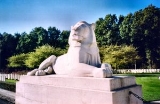
Berks Commonwealth War Graves Commission Cemetery Extension
Encyclopedia
Berks Cemetery Extension is a Commonwealth War Graves Commission
(CWGC) burial ground for the dead of the First World War
located in Ploegsteert
in the Ypres Salient
on the Western Front
.
The cemetery grounds were assigned to the United Kingdom
in perpetuity by King Albert I of Belgium
in recognition of the sacrifices made by the British Empire
in the defence and liberation of Belgium
during the war.
troops in June 1916 as an extension to Hyde Park Corner (Royal Berks) Commonwealth War Graves Commission Cemetery
which lies across the road.
The cemetery was still small at the time of the Armistice
. It was englarged in 1930 when it became clear that Rosenberg Chateau Military Cemetery and Rosenberg Chateau Military Cemetery Extension, approximately one kilometre away, could not be acquired in perpetuity and the graves were moved to the Berks Cemetery Extension.
Inside the cemetery is the Ploegsteert Memorial to the Missing
.
The cemetery was designed by H(arold) Chalton Bradshaw, who also designed the Cambrai Memorial in France.
Commonwealth War Graves Commission
The Commonwealth War Graves Commission is an intergovernmental organisation of six independent member states whose principal function is to mark, record and maintain the graves, and places of commemoration, of Commonwealth of Nations military service members who died in the two World Wars...
(CWGC) burial ground for the dead of the First World War
World War I
World War I , which was predominantly called the World War or the Great War from its occurrence until 1939, and the First World War or World War I thereafter, was a major war centred in Europe that began on 28 July 1914 and lasted until 11 November 1918...
located in Ploegsteert
Ploegsteert
Ploegsteert is a village in Belgium located in the municipality of Comines-Warneton in the Hainaut province. It is approximately 2 kilometres north of the French border. Created in 1850 on part of the territory of Warneton, it includes the hamlet of Le Bizet....
in the Ypres Salient
Ypres Salient
The Ypres Salient is the area around Ypres in Belgium which was the scene of some of the biggest battles in World War I.In military terms, a salient is a battlefield feature that projects into enemy territory. Therefore, the salient is surrounded by the enemy on three sides, making the troops...
on the Western Front
Western Front (World War I)
Following the outbreak of World War I in 1914, the German Army opened the Western Front by first invading Luxembourg and Belgium, then gaining military control of important industrial regions in France. The tide of the advance was dramatically turned with the Battle of the Marne...
.
The cemetery grounds were assigned to the United Kingdom
United Kingdom
The United Kingdom of Great Britain and Northern IrelandIn the United Kingdom and Dependencies, other languages have been officially recognised as legitimate autochthonous languages under the European Charter for Regional or Minority Languages...
in perpetuity by King Albert I of Belgium
Albert I of Belgium
Albert I reigned as King of the Belgians from 1909 until 1934.-Early life:Born Albert Léopold Clément Marie Meinrad in Brussels, he was the fifth child and second son of Prince Philippe, Count of Flanders, and his wife, Princess Marie of Hohenzollern-Sigmaringen...
in recognition of the sacrifices made by the British Empire
British Empire
The British Empire comprised the dominions, colonies, protectorates, mandates and other territories ruled or administered by the United Kingdom. It originated with the overseas colonies and trading posts established by England in the late 16th and early 17th centuries. At its height, it was the...
in the defence and liberation of Belgium
Belgium
Belgium , officially the Kingdom of Belgium, is a federal state in Western Europe. It is a founding member of the European Union and hosts the EU's headquarters, and those of several other major international organisations such as NATO.Belgium is also a member of, or affiliated to, many...
during the war.
Foundation
The cemetery was founded by CommonwealthCommonwealth of Nations
The Commonwealth of Nations, normally referred to as the Commonwealth and formerly known as the British Commonwealth, is an intergovernmental organisation of fifty-four independent member states...
troops in June 1916 as an extension to Hyde Park Corner (Royal Berks) Commonwealth War Graves Commission Cemetery
Hyde Park Corner (Royal Berks) Commonwealth War Graves Commission Cemetery
Hyde Park Corner Cemetery is a Commonwealth War Graves Commission burial ground for the dead of the First World War located in the Ypres Salient on the Western Front....
which lies across the road.
The cemetery was still small at the time of the Armistice
Armistice with Germany (Compiègne)
The armistice between the Allies and Germany was an agreement that ended the fighting in the First World War. It was signed in a railway carriage in Compiègne Forest on 11 November 1918 and marked a victory for the Allies and a complete defeat for Germany, although not technically a surrender...
. It was englarged in 1930 when it became clear that Rosenberg Chateau Military Cemetery and Rosenberg Chateau Military Cemetery Extension, approximately one kilometre away, could not be acquired in perpetuity and the graves were moved to the Berks Cemetery Extension.
Inside the cemetery is the Ploegsteert Memorial to the Missing
Ploegsteert Memorial to the Missing
The Ploegsteert Memorial to the Missing is a Commonwealth War Graves Commission memorial for the missing soldiers of World War I who fought in the immediate area of the Ypres Salient on the Western Front.The grounds were assigned to the United Kingdom in perpetuity by King Albert I of Belgium in...
.
The cemetery was designed by H(arold) Chalton Bradshaw, who also designed the Cambrai Memorial in France.

